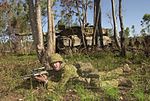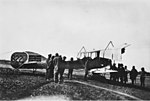Portal:Military history of Australia/Units/February
Units
January • February • March • April • May • June • July • August • September • October • November • December
Please follow the unit sequence of Navy, Army, Airforce when creating Daily Unit pages

Abukir in Egypt. In August 1948, 805 Squadron was re-formed as an RAN FAA squadron operating Hawker Sea Fury Mk II
aircraft. The squadron has been reactivated a total of four times, most recently on 28 February 2001. The
13th Brigade
in the light cavalry role. 
Lord Haw Haw
. 
HMS Javelin
but was scuttled by depth charges at 05:30 on 17 June 1942. 
1st Armoured Regiment
. It also has other combat support and service support units including artillery, engineers, signals and various logistics elements. No. 6 Squadron is a Royal Australian Air Force an electronic warfare squadron that currently operates the Boeing EA-18G Growler. The squadron was first formed in 1917 in Yatesbury, England where it served as a training squadron during the World War I. During World War II the squadron saw combat as a light bomber squadron. Until 2017, No. 6 Squadron served as an operational conversion unit providing training to aircrew before they were posted to No. 1 Squadron RAAF. After this, the squadron converted to the electronic warfare role. The squadron is currently based at RAAF Base Amberley.

Tank Landing Ship which was originally built for the Royal Navy and launched on 28 November 1944 as LST 3017. The ship was loaned to the Royal Australian Navy and commissioned on 4 July 1946. She was named Tarakan on 16 December 1948, and served in Australian and New Guinea waters as a general purpose vessel, but was mainly used for dumping condemned ammunition at sea. On 25 January 1950 seven members of Tarakans crew were killed and the ship extensively damaged by an explosion which occurred while berthed alongside naval base HMAS Kuttabul
in Sydney. Tarakan did not return to active service and was sold for breaking up on 12 March 1954. 
German Spring Offensive and the Hundred Days Offensive
of 1918. 
Bankstown on February 12, 1941. Raised under the Empire Air Training Scheme the squadron became operational in Egypt on 1 July 1941. The squadron at first flew Hawker Hurricanes and Westland Lysander utility aircraft and was employed in an army co-operation role. In February the squadron was relocated to Syria and was converted into a fighter squadron. In early 1944, 451 Squadron was re-equipped with Spitfires and moved to Corsica to assist operation in Southern Europe. The squadron moved to Great Britain in late 1944 and then onto Germany
in 1945. On 21 January 1946 the squadron disbanded. The first
British Eastern Fleet from January 1942 to February 1945, after which she joined the British Pacific Fleet. Norman arrived at Cashmore's in Newport
on 1 April 1958 where she was broken up. 
German East Asia Squadron which threatened merchant shipping in the region. The first Australian to die in combat during the war was a seaman
with the AN&MEF. Following the capture of German possessions in the region, the AN&MEF provided occupation forces for the duration of the war. 
Melbourne on 13 August, the squadron returned to front-line service on 17 January 1943. 452 Squadron remained in the Pacific for the remainder of the war and was disbanded at Balikpapan
on 17 November 1945. 
Bay class frigate laid down by Walkers Limited at Maryborough in Queensland on 18 December 1943, launched on 14 December 1944 by Senator Dorothy Tangney and commissioned at Urangan Jetty in Hervey Bay in Queensland on 2 May 1946. Shoalhaven was the first Australian asset offered for UN service during the Korean War. Shoalhaven paid off to reserve on 19 December 1955, and was sold in January 1962
155mm M198 Howitzers
. The batteries nickname is the The Mighty Tigers 
No. 1 Squadron AFC in Egypt
. 
British Eastern Fleet and was present in Tokyo Bay on Victory over Japan Day (2 September 1945), when the Japanese Instrument of Surrender was signed. Her Australian crew left on 25 October 1945 and she reverted to the Royal Navy. Napier was sold for scrap and arrived at Briton Ferry
on 17 January 1956 where she was broken up. 
Battle of the Hindenburg Line in September 1918, the Australian Corps also contained two American divisions; the 27th and 30th
. Boeing Wedgetail aircraft from RAAF Base Williamtown and RAAF Base Tindal
. 
HMAS Townsville (J 205/M 205/A 124) was a Bathurst-class corvette built by Evans Deakin and Company at Brisbane. HMAS Townsville was launched on 13 May 1941 by Mrs. P. E. McNeil, wife of the Third Member of the Australian Naval Board, and commissioned on 19 December 1941. HMAS Townsville paid off to reserve on 5 August 1946 and was sold for scrap to the Hong Kong
Delta Shipping Company on 8 August 1956. The ship's motto was Bold and Ready. 
Hilton Bombing
in 1978. 104 Field Battery was again disbanded on 1 July 2005 and does not currently feature on the Royal Regiment of Australian Artillery order of battle. 
RAAF Base Laverton on 9 January 1941. No. 5 Squadron also saw action as a helicopter squadron during the Malayan Emergency
and was finally disbanded in December 1989. 
Eastern Fleet. On 11 February 1946 Wollongong paid off at Sydney in preparation for transfer to the Royal Netherlands Navy. Wollongong was renamed HNLMS Banda and served with the Dutch Navy until April 1950. She was handed over to the Indonesian Navy
and renamed Radjawali. She was scraped in April 1968. 
defence of Singapore in February 1942. Following the surrender of Singapore the surviving members of the battalion went into captivity at Changi Prison while some were sent on the Sandakan Death Marches and others to the Thai-Burma Railway
. 
CH-47C Chinook
helicopters. Due to the need to reduce defence expenditure No. 12 Squadron was disbanded on 25 August 1989. 
Westernport for RAN Reserve Training from June 1924 to mid March 1925. During the general reduction in naval activity during the depression it was decided to scrap the entire class and she was towed to sea for use as a Fleet Gunnery Practice Target on 24 November 1930. She withstood considerable shelling before being sunk by a charge of gelignite
. 
1st Brigade
in 1948 and left for Japan for Australia later that year. 
Perth, Western Australia
on 6 February 1939. During the war the squadron was tasked with the role of providing anti-submarine patrols along the West Australian coastline. No. 14 Squadron ceased flying anti-submarine patrols on 23 May 1945 and was disbanded on 10 December 1945 without firing a shot in anger. The Squadron was unique among RAAF Squadrons in that it was based at only a single air base, RAAF Pearce, during its existence. 
R and W Hawthorn at Hebburn, England on 24 September 1940, launched on 28 February 1942, commissioned in the Royal Navy on 26 November 1942, purchased by Australia and commissioned into the RAN on 18 October 1945, paid off into Reserve at Sydney on 20 June 1947, converted to a fast anti-submarine frigate at the Williamstown Naval Dockyard in Melbourne and recommissioned on 16 July 1953. Quadrant was paid off into Operational Reserve at Sydney on 16 August 1957 and was sold for scrap to the Japanese
firm of Kinoshita and Company Limited on 15 February 1963. 
